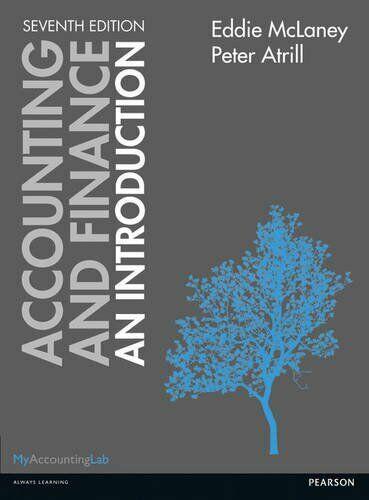Question
Kay McNeil (aged 32 years) is a lawyer employed by a law firm in Hobart. For the income year ended 30 June 2020, Kays employer-provided
Kay McNeil (aged 32 years) is a lawyer employed by a law firm in Hobart. For the income year ended 30 June 2020, Kays employer-provided her with a PAYG payment summary, which included the following:
Gross salary $98,500
Clothing allowance $ 3,000
Total tax withheld (PAYG credits) $22,700
In the 2020 income year, Kays employer provided her with a clothing allowance of $3,000 (see PAYG payment summary information above), which enabled her to buy new clothing during the tax year that she only wore to work. Kays expenditure on clothing during the 2020 year was $2,900. The clothing she purchased was office attire, including shoes, that was suitable for her profession as a lawyer and it did not in any way identify her as an employee of the law firm where she worked.
Kay purchased a laptop computer on 3 July 2019, which she reliably estimates that she used 40% for work purposes. The computer cost Kay $1,320 (including GST), it was first used by Kay on 6 July 2019, and it has an effective life of 3 years.
During the 2019/20 income year, Kay incurred $1,200 (including GST) in mobile phone expenses; however, her employer has reimbursed her in full for these expenses. Kay estimates that 30% of her phone expenses are work related.
Kay sold the following assets during the income year:
- Shares: On 18 June 2014 Kay entered into a contract to purchase 1,000 shares in PER Ltd for $10,000. At the same time, Kay paid brokerage fees of $200 on the purchase of the shares. Kay received a fully franked dividend of $1,400 on these shares on 30 April 2020. Kay sold the shares for $15,200 and paid $200 brokerage on the sale; the contract date was 29 June 2020.
- Coles Bay house: Kay owns two properties. Although she has lived in her Taroona property since she purchased it in 2004, she also owns a house in Coles bay that she uses as his holiday home. Kay purchased the Coles Bay house for $220,000 under a contract dated 10 May 2007, with the settlement date being 19 June 2007. At the time of purchase Kay paid legal fees of $2,200 (including GST) and stamp duty of $3,800.
To purchase the apartment, Kay borrowed $200,000 from the National Australia Bank (NAB) on 10 May 2007 under a 25-year loan agreement at a variable interest rate. NAB charged a $700 loan establishment fee to set up the loan agreement, and Kay also paid stamp duty of $600 on the loan. For the income year ended 30 June 2020, Kay paid interest of $4,790 on the bank loan [note that the total interest payable on the loan up until the sale date was $96,500].
Kay has paid a total of $16,500 (including GST) in insurance premiums on the property since she acquired the house, with $2,000 of that being attributable to the income year ended 30 June 2020. Kay has also paid a total of $7,000 in council rates on the property, with $900 being attributable to the income year ended 30 June 2020.
On 1 November 2019 Kay replaced two windows at the front of the apartment because they were broken due to a severe weather event. The cost of replacing the windows was $550 (including GST). Kay did not claim the expense through her property insurance as the excess on his insurance was much higher than the cost of replacing the windows.
Kay signed a contract on 14 June 2020 to sell the Coles Bay house for $380,000. In relation to the sale, Kay paid legal fees of $3,000 (including GST) and real estate agents commission of $4,400 (including GST). The settlement date for the sale of the apartment was 28 July 2020.
Other Information:
- As at 1 July 2019, Kay had a carried forward capital loss of $1,000 from a sale of shares (a CGT event that occurred in the previous income year), and a carried forward capital loss of $900 from the sale of an artwork.
- On 2 March 2020, Kay donated $1,000 to RSPCA, which is a deductible gift recipient (DGR). She has retained the receipt she was provided with for this donation.
- Kay is an Australian resident for tax purposes for the entire 2019/20 income year and she does not have private health insurance.
Required:
In relation to the above facts:
- Discuss, and calculate Kays net capital gain for the income year ended 30 June 2020. Ensure that you provide complete workings and explanations for every step, and that you include references to the relevant sections of the ITAA97 to support your conclusions
.
- Calculate Kays tax payable/refundable for the income year ended 30 June 2020. Ensure that you justify the inclusion of receipts and expenses in your answer (simply by citing the law that applies) or explain (with reference to relevant law) why an item(s) has not been included in your calculation.
Step by Step Solution
There are 3 Steps involved in it
Step: 1

Get Instant Access to Expert-Tailored Solutions
See step-by-step solutions with expert insights and AI powered tools for academic success
Step: 2

Step: 3

Ace Your Homework with AI
Get the answers you need in no time with our AI-driven, step-by-step assistance
Get Started


